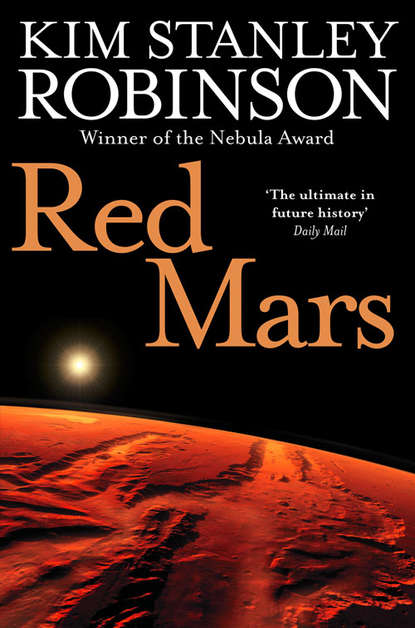По всем вопросам обращайтесь на: info@litportal.ru
(©) 2003-2024.
✖
Red Mars
Автор
Год написания книги
2018
Настройки чтения
Размер шрифта
Высота строк
Поля
And Nadia listened with a careful show of patience, saying “Da, da,” and “I see,” and the like, until Maya was lying flat on her back on the floor, crying, and Nadia was sitting on the edge of a chair staring at her, wondering how much of it was true. And what the argument had really been about. And whether she was a bad friend to distrust her old companion’s story so completely. But somehow the whole thing felt like Maya covering her tracks, practising another manipulation. It was just this: those two distraught faces she had seen down the tunnel had been the clearest evidence possible of a fight between intimates. So Maya’s explanation was almost certainly a lie. Nadia said something soothing to her and went off to bed, thinking, you already have taken too much of my time and energy and concentration with these games, you cost me a finger with them, you bitch!
It was getting toward the end of the long northern spring, and they still had no good supply of water, so Ann proposed to make an expedition to the cap and set up a robot distillery, along the way establishing a route that rovers could follow on automatic pilot. “Come with us,” she said to Nadia. “You haven’t seen anything of the planet yet, just the stretch between here and Chernobyl, and that’s nothing. You missed Hebes and Ganges, and you’re not doing anything new here. Really, Nadia, I can’t believe what a grub you’ve been. I mean why did you come to Mars, after all?”
“Why?”
“Yes, why? I mean there’s two kinds of activities here, there’s the exploration of Mars and then there’s the life support for that exploration. And here you’ve been completely immersed in the life support, without paying the slightest attention to the reason we came in the first place!”
“Well, it’s what I like to do,” Nadia said uneasily.
“Fine, but try to keep some perspective on it! What the hell, you could have stayed back on Earth and been a plumber! You didn’t have to come all this way to drive a goddamn bulldozer! Just how long are you going to go on grubbing away here, installing toilets, programming tractors?”
“All right, all right,” Nadia said, thinking of Maya and all the rest. The square of vaults was almost finished, anyway. “I could use a vacation.”
They took off in three big long-range rovers: Nadia and five of the geologists, Ann, Simon Frazier, George Berkovic, Phyllis Boyle and Edvard Perrin. George and Edvard were friends of Phyllis’s from their NASA days, and they supported her in advocating “applied geological studies", meaning prospecting for rare metals; Simon on the other hand was a quiet ally of Ann’s, committed to pure research and a hands-off attitude. Nadia knew all this even though she had spent very little time alone with any of these people, except for Ann. But talk was talk; she could have named all the allegiances of everyone at base if she had to.
The expedition rovers were each composed of two four-wheeled modules, coupled by a flexible frame: they looked a bit like giant ants. They had been built by Rolls-Royce and a multinational aerospace consortium, and had a beautiful sea green finish. The forward modules contained the living quarters and had tinted windows on all four sides; the aft modules contained the fuel tanks, and sported a number of black rotating solar panels. The eight wire mesh wheels were 2.5 meters high, and very broad.
As they headed north across Lunae Planum they marked their route with little green transponders, dropping one every few kilometers. They also cleared rocks from their path that might disable a robot-driven rover, using the snowplow attachment or the little crane at the front end of the first rover. So in effect they were building a road. But they seldom had to use the rockmoving equipment on Lunae; they drove northeast at nearly their full speed of thirty kilometers an hour for several days straight. They were heading northeast, to avoid the canyon systems of Tempe and Mareotis, and this route took them down Lunae to the long slope of Chryse Planitia. Both these regions looked much like the land around their base camp, bumpy and strewn with small rocks; but because they were heading downhill they often had much longer views than they were used to. It was a new pleasure to Nadia, to drive on and on and see new countryside continually pop over the horizon: hillocks, dips, enormous isolated boulders, the occasional low round mesa that was the outside of a crater.
When they had descended to the lowlands of the northern hemisphere, they turned and drove straight north across the immense Acidalia Planitia, and again ran straight for several days. Their wheel tracks stretched behind them like the first cut of a lawnmower through grass, and the transponders gleamed bright and incongruous among the rocks. Phyllis, Edvard and George talked about making a few side trips, to investigate some indications seen in satellite photos that there were unusual mineral outcroppings near Perepelkin Crater. Ann reminded them irritably of their mission. It made Nadia sad to see that Ann was nearly as distant and tense out here as she was back at base; whenever the rovers were stopped she was outside walking around alone, and she was withdrawn when they sat together in Rover One to eat dinner. Occasionally Nadia tried to draw her out: “Ann, how did all these rocks get scattered around like this?”
“Meteors.”
“But where are the craters?”
“Most are in the south.”
“But how did the rocks get here, then?”
“They flew. That’s why they’re so small. It’s only smaller rocks could be tossed so far.”
“But I thought you told me that these northern plains were relatively new, while the heavy cratering was relatively old.”
“That’s right. The rocks you see here come from late meteor action. The total accumulation of loose rock from meteor strikes is much greater than what we can see, that’s what gardened regolith is. And the regolith is a kilometer deep.”
“It’s hard to believe,” Nadia said. “I mean, that’s so many meteors.”
Ann nodded. “It’s billions of years. That’s the difference between here and Earth, the age of the land goes from millions of years to billions. It’s such a big difference it’s hard to imagine. But seeing stuff like this can help.”
Midway across Acidalia they began running into long, straight, steep-walled, flat-bottomed canyons. They looked, as George noted more than once, like the dry beds of the legendary canals. The geological name for them was fossae, and they came in clusters. Even the smallest of these canyons were impassable to rovers, and when they came on one they had to turn and run along its rim, until its floors rose or its walls drew together, and they could continue north over flat plain again.
The horizon ahead was sometimes twenty kilometers off, sometimes three. Craters became rare, and the ones they passed were surrounded by low mounds that rayed out from the rims: splosh craters, where meteors had landed in permafrost that had turned to hot mud in the impact. Nadia’s companions spent a day wandering eagerly over the splayed hills around one of these craters; the rounded slopes, Phyllis said, indicated ancient water as clearly as the grain in petrified wood indicated the original tree. By the way she spoke Nadia understood that this was another of her disagreements with Ann; Phyllis believed in the long wet past model, Ann in the short wet past. Or something like that. Science was many things, Nadia thought, including a weapon with which to hit other scientists.
Further north, around latitude 54°, they drove into the weird-looking land of thermokarsts, hummocky terrain spotted by a great number of steep-sided oval pits, called alases. These alases were a hundred times bigger than their Terran analogues, most of them two or three kilometers across, and about sixty meters deep. A sure sign of permafrost, the geologists all agreed; seasonal freezing and thawing of the soil caused it to slump in this pattern. Pits this big indicated that water content in the soil must have been high, Phyllis said. Unless it was yet another manifestation of Martian time scales, Ann replied. Slightly icy soil, slumping ever so slightly, for eons.
Irritably Phyllis suggested that they try collecting water from the ground, and irritably Ann agreed. They found a smooth slope between depressions, and stopped to install a permafrost water collector. Nadia took charge of the operation with a feeling of relief; the trip’s lack of work had begun to get to her. It was a good day’s job: she dug a ten-meter long trench with the lead rover’s little backhoe; laid the lateral collector gallery, a perforated stainless steel pipe filled with gravel; checked the electric heating elements running in strips along the pipe and filters; then filled in the trench with the clay and rocks they had dug out earlier.
Over the lower end of the gallery was a sump and pump, and an insulated transport line leading to a small holding tank. Batteries would power the heating elements, and solar panels charge the batteries. When the holding tank was full, if there was enough water to fill it, the pump would shut off and a solenoid valve would open, allowing the water in the transport line to drain back into the gallery, after which the heating elements would shut off as well.
“Almost done,” Nadia declared late in the day, as she started to bolt the transport pipe onto the last magnesium post. Her hands were dangerously cold, and her maimed hand throbbed. “Maybe someone could start dinner,” she said. “I’m almost done here.” The transport pipe had to be packed in a thick cylinder of white polyurethane foam, then fitted into a larger protective pipe. Amazing how much insulation complicated a simple piece of plumbing.
Hex nut, washer, cotter pin, a firm tug on the wrench. Nadia walked along the line, checking the coupling bands at the joints. Everything firm. She lugged her tools over to Rover One, looked back at the result of the day’s work: a tank, a short pipe on posts, a box on the ground, a long low mound of disturbed soil running uphill, looking raw but otherwise not unusual in this land of lumps. “We’ll drink some fresh water on our way back,” she said.
They had driven north for over two thousand kilometers, and finally rolled down onto Vastitas Borealis, an ancient cratered lava plain that ringed the northern hemisphere between latitudes 60° and 70°. Ann and the other geologists spent a couple of hours every morning out on the bare dark rock of this plain, taking samples, after which they would drive north for the rest of the day, discussing what they had found. Ann seemed more absorbed in the work, happier. One evening Simon pointed out that Phobos was running just over the low hills to the south; the next day’s drive would put it under the horizon. It was a remarkable demonstration of just how low the little moon’s orbit was; they were only at latitude 69°! But Phobos was only some five thousand kilometers above the planet’s equator. Nadia waved goodbye to it with a smile; she would still be able to talk to Arkady using the newly arrived areosynchronous radio satellites.
Three days later the bare rock ended, running under waves of blackish sand. It was just like coming on the shore of a sea. They had reached the great northern dunes, which wrapped the world in a band between Vastitas and the polar cap; where they were going to cross, the band was about eight hundred kilometers wide. The sand was a charcoal color, tinged with purple and rose, a rich relief to the eye after all the red rubble of the south. The dunes trended north and south, in parallel crests that occasionally broke or merged. Driving over them was easy; the sand was hard-packed, and they only had to pick a big dune and run along its humpbacked western side.
After a few days of this, however, the dunes got bigger, and became what Ann called barchan dunes. These looked like huge frozen waves, with faces a hundred meters tall and backs a kilometer wide; and the crescent that each wave made was several kilometers long. As with so many other Martian landscape features, they were a hundred times larger than their Terran analogs in the Sahara and Gobi. The expedition kept a level course over the backs of these great waves by contouring from one wave back to the next, their rovers like tiny boats, paddlewheeling over a sea that had frozen at the height of a titanic storm.
One day on this petrified sea, Rover Two stopped. A red light on the control panel indicated the problem was in the flexible frame between the modules; and in fact the rear module was tilted to the left, shoving the left side wheels into the sand. Nadia got into a suit and went back to have a look. She took the dust cover off the joint where the frame connected to the module chassis, and found that the bolts holding them together were all broken.
“This is going to take a while,” Nadia said. “You guys might as well have another look around.”
Soon the suited figures of Phyllis and George emerged, followed by Simon and Ann and Edvard. Phyllis and George took a transponder from Rover Three and set it out three meters to the right of their “road”. Nadia went to work on the broken frame, handling things as little as possible: it was a cold afternoon, perhaps seventy below, and she could feel the diamond chill right down to the bone.
The ends of the bolts wouldn’t come out of the side of the module, so she got out a drill and started drilling new holes. She began to hum “The Sheik of Araby”. Ann and Edvard and Simon were discussing sand. It was so nice, Nadia thought, to see ground that wasn’t red. To hear Ann absorbed in her work. To have some work to do herself.
They had almost reached the arctic circle, and it was Ls = 84, with the northern summer solstice only two weeks away; so the days were getting long. Nadia and George worked through the evening while Phyllis heated supper, and then after the meal Nadia went back out to finish the job. The sun was red in a brown haze, small and round even though it was near setting; there wasn’t enough atmosphere for oblation to enlarge and flatten it. Nadia finished, put her tools away, and had opened the outer lock door of Rover One, when Ann’s voice spoke in her ear. “Oh Nadia, are you going in already?”
Вы ознакомились с фрагментом книги.
Приобретайте полный текст книги у нашего партнера:
Приобретайте полный текст книги у нашего партнера:











